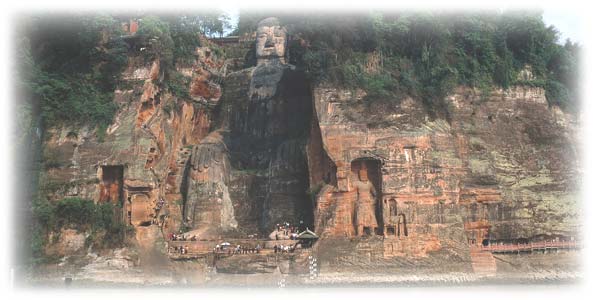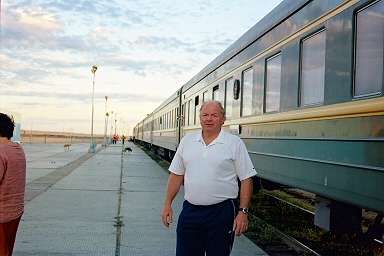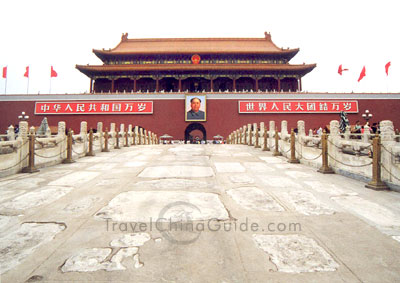After a week in California, I packed-up and left for Shanghai on July 28th. My flight took me through Los Angeles and Tokyo, but for the fare, I could not complain. I took an apartment at New Harbor where I've stayed several times previously. Cindy flew down from Beijing and met me on Friday. Mom & my sister Carolyn, who have been on a Trafalgar tour of China for the last two weeks, also arrived in Shanghai on Friday. They still had two days of their tour left in Shanghai before the organized portion ended on Sunday morning. On August 1st, we all flew to Kumming and then on to LiJiang in Yunnan Province. We had to take two taxis to the Guan Fang Hotel which we planned to use as a base of operations for the next several days. I had visited LiJiang with Cindy last year and thought that Carolyn & mom would be interested in the Naxi Culture and the authenticity of the ancient villages. I was surprised to see how much the place had changed just in the last year. There is ramped commercialization including a whole new 'ancient town' being built by the government for tourists. Carolyn's birthday was August 2nd and we celebrated with a special birthday dinner in the ancient town. I ordered the traditional birthday food of fried dragonflies which turned out to be more than all of us could eat. We also spent an evening at a Naxi Music Festival which, although it included lengthy explanations of the history of the music in Chinese, was still enjoyable to the point that none of us fell asleep. On August 4th, we flew back to Kumming where we said good-bye to Cindy and then went on to Hong Kong. Chinese Nationals still need a special visa to go to Hong Kong which Cindy did not have so she went to Chengdu to do some sightseeing on her own. We checked into the Mandarin Oriental for the first two nights. Thursday it was hot and humid so we took the tram up to The Peak where we had great views of Victoria Harbor, and then spent the afternoon shopping. In the evening, we took a taxi to Aberdeen where we found mom a sampan to ride and went to Jumbo, the floating restaurant for dinner. On August 6th, we moved across the harbor to Kolwoon where we checked into The Intercontinental for the final two nights. Although it was pouring rain the day we moved, Carolyn & mom took The Star Ferry while I moved the luggage in a taxi. The room I had taken for them had a fabulous view of the harbor. Mom really seemed to enjoy watching all the shipping traffic out the window. We decided the view was so good, I bought some food at a local market and we had a picnic in their room as we watched the light show across the harbor. The light show was performed by the buildings on the Hong Kong side and was set to music. Saturday after the wonderful breakfast buffet, we took a harbor cruise over to the container port where we were able to see the ships being loaded and off-loaded. We returned in time for mom's 3rd massage of the week, and then ordered room service to eat again in their room. Sunday morning after breakfast we checked-out. A car picked us up at 8:00 AM and took us to the airport. Carolyn & mom were on a 1:40 PM flight back to the states, but I had a 10:40 AM flight to Chengdu where I planned to reconnect with Cindy and, hopefully, go to Tibet.
It was in Chengdu that I really started to appreciate he huge number of people in China. You expect to see lots of people in places like Beijing, Shanghai & Hong Kong, but this is my fifth trip to China in the last two years and I had never even heard of Chengdu. Yet here was a city the size of Chicago with sidewalks 25 feet wide on both sides of the street, yet at 10:00 at night you still have to walk in the street because there are too many people on the sidewalk. On Wednesday, August 11th, we took a two-hour flight to Beijing. This was my first time in Beijing in almost 2 years and the city seemed bigger. We took a room at The Landmark Hotel in a complex with a Sheraton, a couple embassies and a Hard Rock Cafe. It was good to eat western food again-even if it had a Chinese tint to it. Cindy needed to prepare for her tour which starts on Sunday so we visited The Lama Temple so she could refresh her memory of its history and went to dinner at a couple places where her group is scheduled to eat. The tour she is leading is made up of 30 people attending her best friend's wedding next Saturday. We also visited a pearl outlet where I bought some gifts.
On Tuesday morning, I said goodbye to Cindy and took a taxi to the Beijing Railroad Station. The Trans-Mongolian Railroad leaves Beijing twice a week for Lake Baikal where it meets the Trans-Siberian Railroad. From here, you can go west to Moscow or east to Vladivostok. My first class ticket cost $150 which didn't seem too bad. If all goes well, I'll be in Ulaanbaatar by 1:30 PM Wednesday. My carriage has eight compartments, each with two beds and a table. Each compartment shares a shower & sink with the compartment next door. There is a toilet at the end of the carriage. The train is full, except for the other bed in my compartment, so I will have privacy all the way to Ulaanbaatar. The train left exactly at 7:40 AM. Within half an hour we were outside the main city of Beijing and by 9:00 AM we had reached the Great Wall, snaking its way up and down the ridgelines.
Thirteen hours into the trip we reached the point where we crossed from Chinese Inner Mongolia into Mongolia, which the Chinese still refer to as Outer Mongolia. The Chinese trains run on standard gauge track while the Mongolian trains run on the Russian narrow gauge track. So in order to facilitate the change, our 10 carriage train was driven into a building, the cars were separated, and four large lifts raised each carriage (with us in them) about six feet in the air while they changed the wheels. The whole process took about an hour. This stop was also the first of four passport checks we would go through during the night. I slept as well as could be expected on a moving train and awoke just as the train was entering Saynahand. We stopped for about 20 minutes, just long enough to get out and stretch our legs, and then continued north through The Gobi. I had read that Mongolia is supposed to have about one person per square kilometer, but I couldn't see anyone. At 9:00 AM we reached Choyr, the last stop before Ulaanbaatar. The station was crowded with children selling water and other things the tourists might need.
I had come to Mongolia with no specific plans, but had hoped that I could hook up with a group and do some hiking in The Gobi Desert or spend a couple of nights in a Ger. I was not having much success, however, finding an organized tour with an English guide that I could join. I had met a guy on the train who was going to Lake Baikal and then heading east for Vladivostok on the Trans-Siberian train, and on to Japan by ferry. Although this meant four more days on the train, I decided to look into this option. Obtaining a Russian visa, however, was a big hurdle as the normal amount of time required was 9 days. I could reduce it to 3 by paying a hefty premium, but the real issue was that I could not buy a seat on the Trans-Siberian train until one day before the train reaches Lake Baikal, which means I could be stuck there for a week or more, just waiting to get out. With so many uncertainties, I decided to just fly to Japan, cutting my visit to Ulaanbaatar to just five days. The local paper had a front page article about the marriage of an important Sumu wrestler to a local Mongolian girl. I had seen some coverage of this event on local TV, but since the audio had been in Mongolian, I could not understand. But the ceremony was very large with lots of guests. The article in the paper talked about how the wedding had been delayed while the wrestler and his manager had negotiated the terms of the wedding dowry & gifts. It is customary for managers to receive 60% of a wrestler’s income and apparently that extends to wedding gifts and cash gifts also. The paper did not say how the wrestler and his manager had settled the matter, but seemed to indicate that the manager was within his rights to demand 60% of the wedding gifts. On Friday when I changed hotels from The Bayangol to the Chinggis Khaan Hotel, I saw over a dozen giant Japanese Sumu wrestlers in the lobby of the Chinggis Khann who obviously were here for the wedding. I found a travel agent and bought a ticket to Tokyo. I also went to the National Museum of Mongolian History on Saturday which had several interesting exhibits from Attila the Hun and Chinggis Khann (a/k/a Genghis Khan) to Chinese rule, Russian rule up to the present democracy. On Sunday, I visited the State Department Store where I bought some souvenirs and went to the Natural History Museum. The museums exhibits were in poor condition, although some of the dinosaur relics were interesting. I spent a couple hours in the afternoon exploring parts of the city I had not seen before and then went back to the hotel to write my journal. Tomorrow morning I will fly to Tokyo. |




